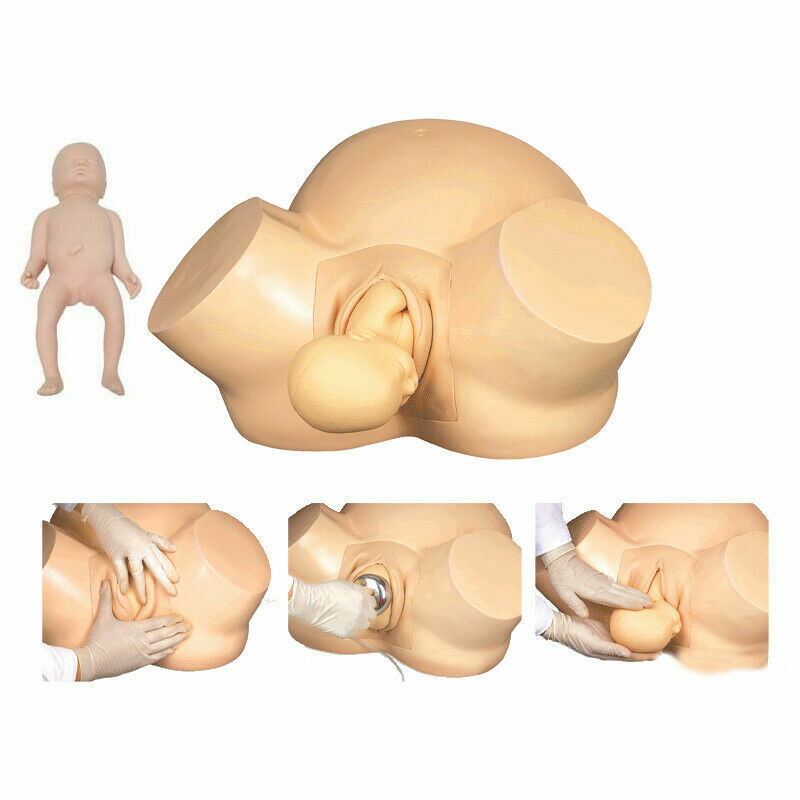

When every second counts in a delivery room, preparation is everything. The Myaskro Vacuum Delivery Simulator Model gives medical professionals, midwives, and students a realistic, hands-on training experience for one of obstetrics' most critical interventions: vacuum-assisted birth.
This childbirth simulator is more than just a mannequin—it’s a clinical teaching tool designed to replicate the complexity of assisted vaginal delivery. Crafted from soft, skin-like materials and anatomically accurate in form, the model allows learners to practice correct positioning, cup placement, traction direction, and fetal head manipulation in real time.
Whether you're running obstetric emergency drills, training new midwifery students, or teaching residents in a hospital setting, this model delivers realistic resistance and response. It builds confidence before the first patient is ever involved. Instructors can simulate various fetal positions and scenarios, including stalled labor or malposition, enabling students to adapt and respond without pressure or risk.
One of the first questions educators ask: “Does it replicate real-life birthing challenges?” Unequivocally, yes. The model's resistance levels and vaginal canal elasticity simulate the tactile feedback felt during actual vacuum deliveries. You can rehearse everything from station descent to crowning—and even improper cup applications to understand complications.
Search engines love the detail too. The Myaskro model aligns with queries like “vacuum delivery trainer,” “obstetric simulation model,” “childbirth education tools,” and “midwifery training simulator”. And for good reason: it’s built for medical precision, classroom functionality, and patient-safe training outcomes.
“This simulator changed how we teach assisted births. It’s responsive, detailed, and has helped our students drastically improve their technique before entering clinical rotations,” says Dr. Helena S., OB-GYN Program Director, Dublin.
Durable, compact, and remarkably realistic, the Myaskro Vacuum Delivery Simulator becomes a vital part of obstetric training programs worldwide. It’s not just about practicing technique—it’s about preparing for the moments where skill meets urgency. This is where readiness begins.
The Myaskro Vacuum Delivery Simulator is engineered with one goal in mind: to help medical trainees gain hands-on confidence in vacuum-assisted deliveries without risk to real patients. It features a full pelvic torso and a lifelike fetal head, allowing complete simulation of station, rotation, engagement, and expulsion—the real steps of vacuum delivery, not just theory.
This training model lets you replicate common and uncommon scenarios. Is the baby occiput posterior? You can simulate it. Is the head asynclitic? Practice makes perfect. The birthing canal is elastic, the fetal head is soft yet firm, and the integrated vacuum-compatible scalp provides realistic suction feedback for cup placement and traction training.
Healthcare educators often wonder: “Does it respond to technique like an actual birth would?” Yes. This model provides resistance against improper pull angles and encourages correct hand positioning. When you train with Myaskro, you don’t just learn *how* to deliver—you learn when to reassess, reposition, or pause. That’s the nuance professionals need.
It’s ideal for OSCE training, emergency simulations, midwife workshops, and labor & delivery residencies. Medical simulation centers frequently praise its portability and durability, as the soft vinyl and polymer blend used in construction resists tearing, staining, and wear from repeated use.
Integrated anatomical details include the perineum, vulva, and internal birth canal, making it an excellent companion to broader OB/GYN simulation programs. Instructors can easily guide students through techniques like episiotomy training, recognizing fetal descent progression, and understanding tissue resistance—without risk or discomfort to patients.
Semantic keywords that bring users here include “vacuum-assisted birth model,” “labor simulation dummy,” “childbirth teaching manikin,” and “obstetric training equipment.” Every click from those queries finds a tool that doesn’t disappoint in performance or realism.
“As a midwifery instructor, I’ve worked with many simulators. This one provides the most accurate feel and real-time response to force, making it indispensable for safe practice,” shares Melanie T., Senior Clinical Lecturer, Cape Town.
Whether in a med school, hospital residency, or nursing program, the Myaskro simulator prepares future professionals for real delivery room scenarios—because in birth, confidence saves seconds, and seconds save lives.
Simulation-based training has transformed medical education—and nowhere is that transformation more vital than in labor and delivery. The Myaskro Vacuum Delivery Simulator ensures that every student, resident, or practitioner enters the birthing room with more than textbook knowledge. They arrive with practiced hands and calm decision-making, born from muscle memory and repetition.
This simulator isn't just about the mechanics of vacuum delivery. It's about teaching the feel of resistance, the angle of approach, and the nuance of fetal positioning. Instructors can demonstrate complications like shoulder dystocia or failed vacuum attempts, and students can rehearse both standard and emergency protocols. It’s real-time education, minus the risk.
Wondering if it holds up over time? It does. Made from durable synthetic elastomers that replicate the elasticity of human tissue, the Myaskro model endures frequent practice sessions without losing integrity or realism. Its modular design also allows for easy cleaning and reassembly between sessions, making it ideal for busy academic and clinical environments.
It serves learners at all levels: first-year midwifery students, final-year medical students, OB/GYN residents, labor nurses, and even emergency room staff training for obstetric emergencies. With this model, every skill becomes teachable, repeatable, and perfectible.
From a visibility standpoint, it satisfies the intent behind key queries like “OB vacuum delivery trainer,” “birth assistance simulation model,” “clinical obstetric training device,” and “perinatal education equipment.” Because behind each of those searches lies the same need—for a better, safer way to teach one of medicine’s most delicate procedures.
“We use this every semester. New students quickly gain confidence, and our instructors can demonstrate complications with ease. It’s the gold standard for vacuum delivery training,” reports Dr. Kamal D., Program Coordinator, Women’s Health Division, Bangalore.
Place it in your teaching lab, your OB simulation suite, or your continuing education center. Then observe what happens when confidence replaces hesitation. When understanding replaces uncertainty. That’s the quiet power of the Myaskro model. It doesn’t just train practitioners—it helps shape better outcomes, one simulation at a time.
Total Reviews (0)